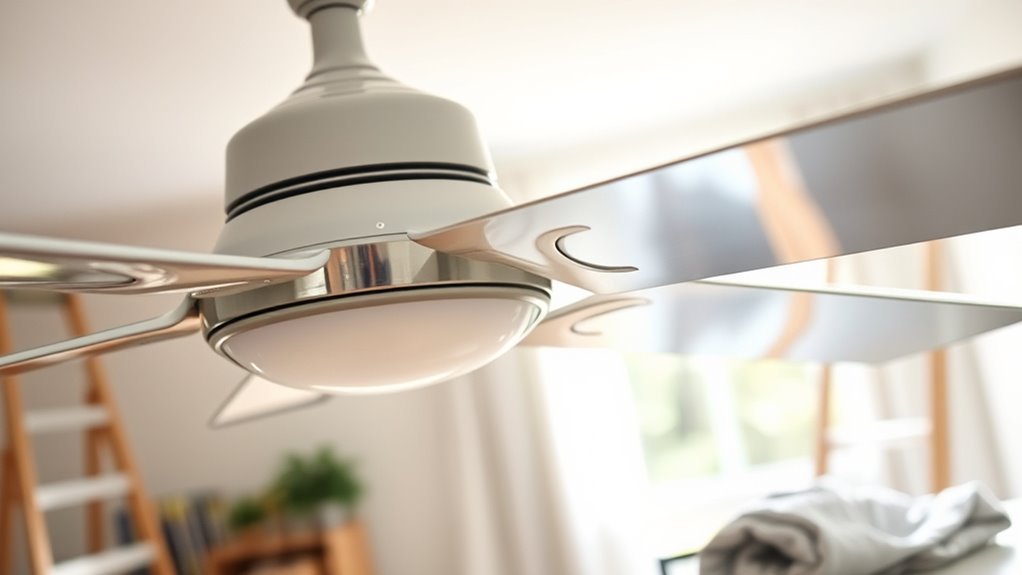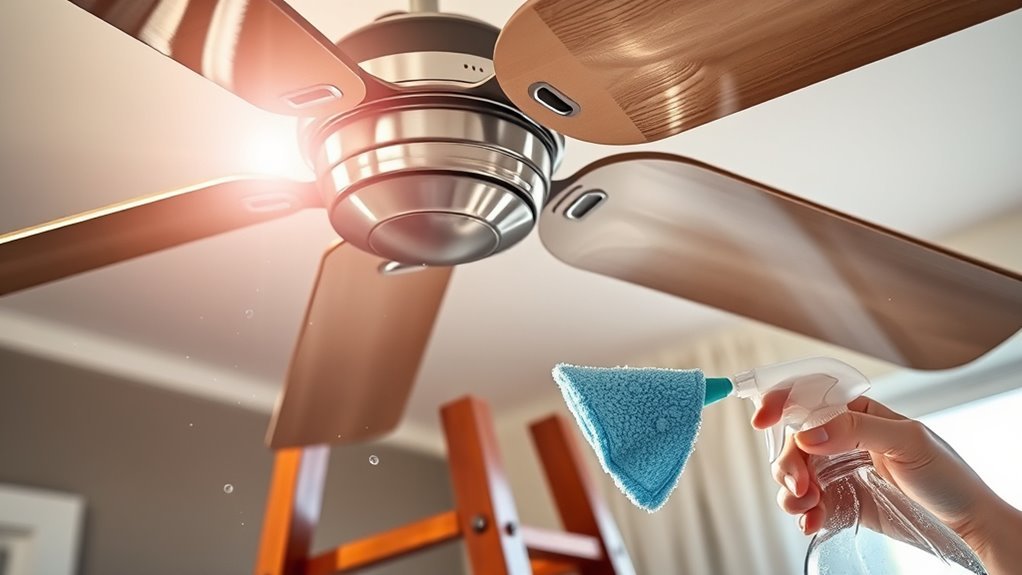How to Clean Fan
To clean your fan, first unplug it for safety and gather soft cloths, a brush, and mild soap. Remove grills and blades if possible, then wipe them down gently to remove dust. Use a small brush for tight spots and let all parts dry completely. Regular cleaning helps your fan run smoothly and reduces dust buildup. Keep going to discover how to clean different fan types and maintain your fan for long-lasting performance.
Tools and Materials Needed for Cleaning Fans

To clean a fan effectively, you’ll need a few essential tools and materials. Start by gathering a soft cloth or microfiber towel to wipe away dust without scratching surfaces. A small brush or toothbrush helps reach tight spots between blades and vents. For tougher grime, choose gentle cleaning solutions that won’t damage the fan’s finish—mild soap mixed with water works perfectly. Avoid harsh chemicals to preserve your fan’s lifespan. You’ll also want a screwdriver if you need to remove parts for deeper fan maintenance. Having a vacuum with a brush attachment can speed up dust removal. With these tools, you’re equipped to keep your fan running smoothly and efficiently, granting you the freedom of a clean, invigorating breeze anytime.
Safety Precautions Before Cleaning Your Fan
Before you start cleaning your fan, make sure to unplug it to avoid any electrical hazards. You should also wear protective gear like gloves and a mask to keep dust and debris away. Finally, place the fan on a stable surface so it won’t tip over while you’re working.
Unplugging the Fan
One essential step you’ll want to take before cleaning your fan is unplugging it from the power source. This simple act is key to fan safety and guarantees your fan maintenance routine is both effective and risk-free. You deserve the freedom to clean without worry, so follow these steps:
- Locate the fan’s plug and gently pull it from the outlet—never yank the cord.
- Double-check the fan is fully off, confirming no power runs through it.
- If your fan has a removable cord, detach it for extra safety.
- Keep the unplugged fan away from water or damp areas until cleaning is complete.
Unplugging means you control safety, giving you peace of mind and total freedom during your fan maintenance.
Using Protective Gear
Once you’ve unplugged your fan, it’s smart to gear up for cleaning to protect yourself from dust and debris. Wearing protective gloves will keep your hands safe from sharp edges and stubborn dirt, while safety goggles shield your eyes from airborne particles. These simple steps help you maintain freedom from allergies and injuries. Here’s a quick guide to the essential gear:
| Protective Gear | Purpose |
|---|---|
| Protective Gloves | Prevent cuts and skin irritation |
| Safety Goggles | Protect eyes from dust and debris |
| Face Mask | Avoid inhaling dust particles |
| Long Sleeves | Shield skin from allergens |
| Closed Shoes | Guard feet from falling objects |
Suiting up this way guarantees a safe, efficient cleaning process without compromising your well-being or freedom.
Ensuring Stable Placement
Although unplugging your fan is essential, you’ll also want to make certain it’s placed on a stable, flat surface to prevent it from tipping over while you clean. Fan stability is key to a secure installation that keeps you safe and your fan intact. Here’s how to ascertain that:
- Choose a level surface free from clutter, so your fan won’t wobble or shift.
- Avoid edges or uneven floors that risk a sudden fall.
- If possible, use rubber pads or non-slip mats under the fan’s base for extra grip.
- Double-check the fan’s balance before you start cleaning to keep everything steady.
Taking these steps frees you to clean confidently without worrying about accidents or damage.
How to Clean a Table Fan
Cleaning a table fan involves just a few simple steps that can make a big difference in its performance and air quality. First, unplug your fan to guarantee safety. Remove the front grill by loosening clips or screws, then carefully take off the blades. Wipe the blades and grill with a damp cloth or mild detergent to remove dust and grime. Avoid getting the motor wet to prevent damage. Regular fan maintenance like this boosts fan efficiency, letting you enjoy fresher air and quieter operation. After cleaning, reassemble the parts securely. Keeping your table fan clean not only extends its life but also gives you the freedom to breathe easier and feel cooler without hassle. Make cleaning a routine for ideal results.
Steps to Clean a Ceiling Fan

To clean your ceiling fan, start by gathering the right supplies like a microfiber cloth and a gentle cleaner. You’ll want to dust off the blades carefully before wiping them down to remove any stubborn dirt. Taking these steps guarantees your fan stays dust-free and runs smoothly.
Gather Cleaning Supplies
Before you start, gather a few essential supplies to make the job easier and safer. Having everything ready helps you breeze through cleaning techniques and enjoy the freedom that comes with efficient fan maintenance. Here’s what you’ll need:
- A sturdy step ladder – to safely reach your ceiling fan without strain.
- Microfiber cloths – perfect for trapping dust without scattering it.
- A gentle all-purpose cleaner or a mix of water and mild soap – to wipe away grime without damaging blades.
- A vacuum with a brush attachment – for removing stubborn dust from hard-to-reach spots.
With these tools, you’re set to reclaim control over your space, ensuring your fan runs smoothly and your home feels fresher.
Dust and Wipe Blades
Start by using your microfiber cloth to gently dust each blade, making sure you support the blade with one hand to prevent bending. Different blade types—whether wooden, metal, or plastic—need careful handling to avoid damage. For wooden blades, avoid excessive moisture; a slightly damp cloth works best. Metal and plastic blades can usually handle a bit more cleaning solution but always check manufacturer guidelines. Your cleaning frequency depends on your environment—dusty areas might require weekly attention, while cleaner spaces can get by with monthly cleanings. Regular dusting not only keeps your fan running smoothly but also improves air quality and frees you from sneezing fits. Stay consistent, and your fan will stay as invigorating and liberating as the breeze it creates.
Best Practices for Cleaning a Pedestal Fan
Cleaning a pedestal fan involves a few simple steps that can keep it running efficiently and extend its lifespan. Knowing the right cleaning frequency is essential, especially since different fan types need varying care. Here’s how you can maintain your pedestal fan freely and effectively:
Regular cleaning keeps your pedestal fan efficient and extends its life with just a few simple steps.
- Unplug the fan to guarantee safety before starting.
- Remove the front grill and blades carefully for thorough cleaning.
- Use a damp cloth or mild soap solution to wipe dust and grime off all parts.
- Let everything dry completely before reassembling to avoid damage.
Cleaning Tips for Exhaust and Wall-Mounted Fans

Although exhaust and wall-mounted fans are typically less accessible than pedestal fans, you can still keep them in top shape with regular maintenance. Start by turning off the power to avoid accidents. For exhaust fan maintenance, remove the cover and gently vacuum or wipe away dust and grime from the blades and vent. This clears airflow and prevents overheating. When it comes to wall mounted fan care, use a soft cloth or brush to clean the blades and housing. Avoid harsh chemicals that can damage surfaces. Don’t forget to check for any loose screws or parts and tighten them as needed. By routinely giving your fans this attention, you’ll enjoy better air circulation and extend their lifespan—all while keeping your space fresh and free.
Maintaining Your Fan for Long-Term Efficiency
To keep your fan running efficiently over time, you’ll need to perform regular maintenance beyond just cleaning. This efficiency maintenance is key to enjoying fan longevity and the freedom of consistent airflow without worry. Here’s how you can guarantee your fan stays in top shape:
Regular maintenance beyond cleaning ensures your fan’s longevity and consistent, worry-free airflow.
- Lubricate moving parts every few months to reduce friction and noise.
- Tighten screws and bolts to prevent wobbling and wear.
- Check electrical connections for safety and uninterrupted operation.
- Store your fan properly during off-seasons to avoid dust buildup and damage.
Frequently Asked Questions
How Often Should I Clean My Fan for Optimal Performance?
You should stick to a regular cleaning frequency to keep your fan running smoothly and efficiently. For peak performance, fan maintenance tips suggest cleaning it every one to three months, depending on usage and dust levels. If you live in a dusty area or use your fan daily, cleaning more often helps maintain airflow and prevents buildup. Staying on top of this frees you from clogged fans and keeps your space comfortable without hassle.
Can I Use Water Directly on Electric Fan Motors?
You shouldn’t use water directly on electric fan motors because it risks damaging the motor and causing electrical hazards. For proper fan motor maintenance, always follow cleaning precautions like unplugging the fan first and using a dry cloth or compressed air to remove dust. Staying cautious lets you enjoy your fan freely without worrying about malfunctions or safety issues, keeping your fan running smoothly and safely for longer.
What Is the Best Way to Remove Fan Odors?
To tackle fan odor removal and eliminate musty smells, you’ll want to start by unplugging your fan and wiping down all surfaces with a cloth dampened in a mix of vinegar and water. This natural solution breaks down odors without harsh chemicals. Don’t forget to clean the blades and grill thoroughly. Let everything dry completely before turning it back on. This way, you’re freeing yourself from unpleasant smells and enjoying fresh air again.
Are There Specific Cleaning Products to Avoid on Fan Blades?
You’ll want to avoid harsh cleaning solutions like ammonia or bleach on fan blades since they can damage certain blade materials, especially wood or painted surfaces. Stick to mild soaps or specialized cleaners suited for your fan’s blade materials to keep them safe and looking great. Using the wrong products might strip finishes or cause warping, so choosing gentle solutions lets you maintain freedom to clean without risking damage.
How Do I Troubleshoot a Fan That Still Makes Noise After Cleaning?
If your fan keeps making noise after cleaning, start troubleshooting fan issues by checking for loose screws or unbalanced blades—they often cause unwanted sounds. Tighten any loose parts and make sure the blades spin freely. Lubricate the motor bearings if it’s noisy. For fan noise reduction, consider placing the fan on a stable surface and ensuring nothing’s obstructing airflow. These steps should help you enjoy quieter, more freedom-filled airflow.






